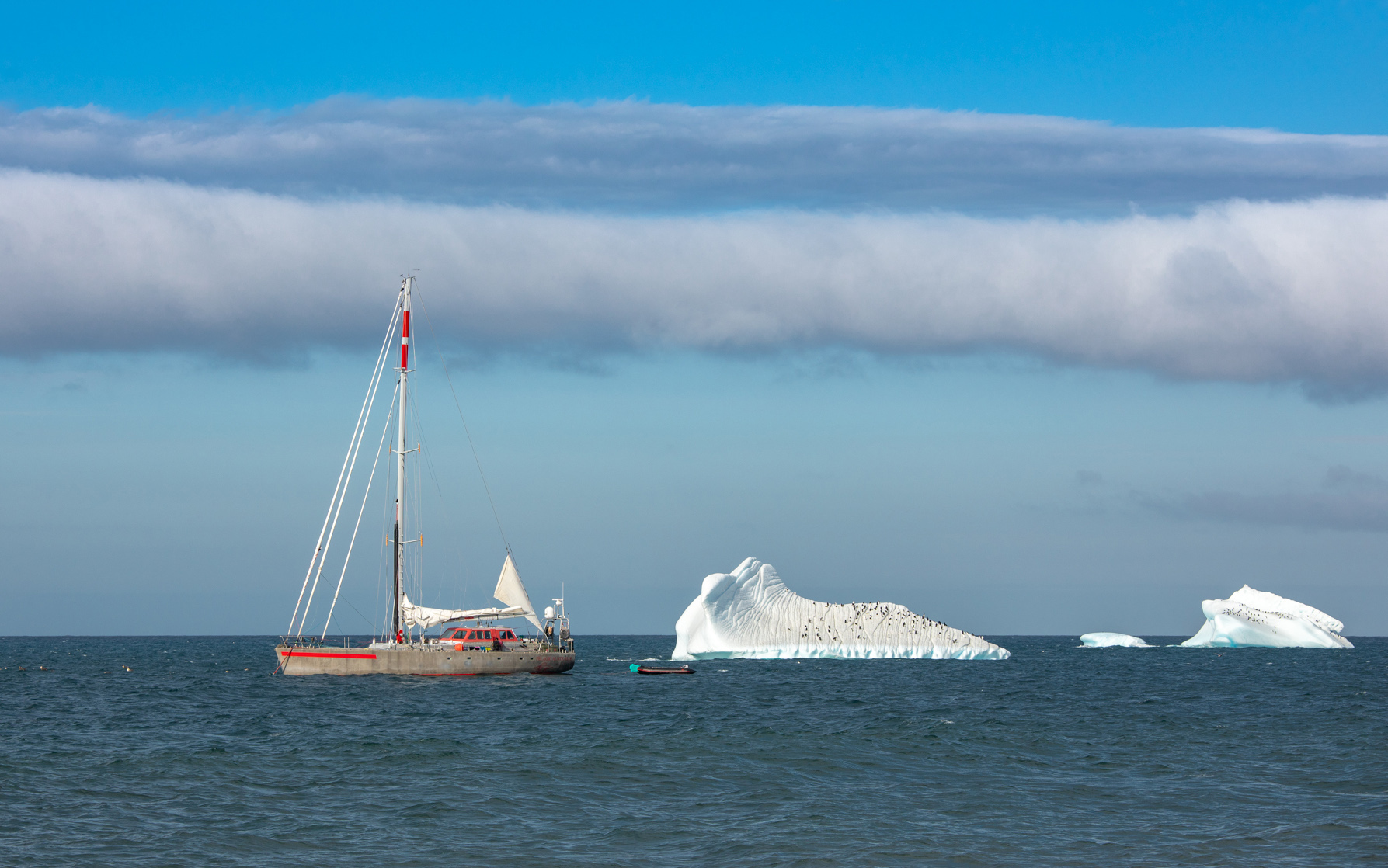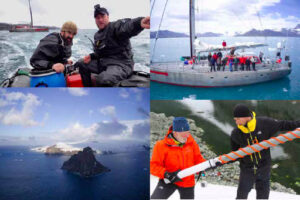
South Sandwich Islands Expedition
An Awful and Wonderful Place: Journey to the South Sandwiches
Expedition Dates: December 2020 – Feb 2021
Field Team: Paul Mayewski, Mariusz Potocki
University of Maine – Climate Change Institute
Penguin News, February 7, 2020

PENGUIN News caught up with Pelagic Expeditions’ Skip Novak and three members of the multi-disciplinary scientific expedition that recently spent five weeks on and around South Georgia and the South Sandwich Islands aboard the Pelagic Australis.
SHOWING the caution of a man with some 30 years’ experience of sailing in the Southern Ocean, Skip Novak admits he was skeptical about the prospects of delivering an ambitious scientific programme in the South Sandwich Islands: “It is a very dodgy area to work in; it has a reputation for getting 10% done out of what you want to get done.”
As it was, the team lucked out. The weather gods smiled upon them and with a suite of drone technology available to them, the expedition met the majority of its goals.
The main driver behind the expedition was the volcanic activity recorded across the South Sandwich Islands in 2016, explains Dr. Tom Hart, chief science co-ordinator for the expedition.
The South Sandwiches are home to the largest colony of any vertebrate animal in the world: 1.3 million pairs of chinstrap penguins and 60,000 pairs of macaroni. With field visits few and far between and no reliable satellite imagery to call upon, it became all the more imperative to see how the colony had fared in the wake of the eruptions.
“Because it is so hard to get people there, we wanted to hit as much as possible,” says Tom. “We wanted to resurvey all the main islands that were previously surveyed and see how they’d changed, get some diet and fecal samples and tell what they’d been eating. We put some trackers out to see how they’re using the ocean compared to the Marine Protected Area around there.”
Off the back of the penguin studies, other fields were added: climate change, glaciology, volcanology, cetaceans. “It was just too good an opportunity to miss, it’s so rare to get people there. Unfortunately for Skip we just filled the boat up.” “It was pretty crowded,” agrees Skip. “Fourteen people including crew. But we’re still all talking to each other, which is pretty great.”
Crowded though the Pelagic may have been, the expedition was a, “pretty big success for team penguin,” concludes Tom. “We got almost all the samples we wanted, we got all the trackers, and we counted nearly everything we wanted with the drone.” The team was prepared for the need to be light and fast, he says, but in the end, it was the weather that was the biggest asset, “we filled [the boat] full of science and full of people, you can go there and achieve nothing … We were very lucky.”
Accurate counts will take time to process, but for the moment, the colony seems to have survived the volcanic activity, says Tom, “thankfully it was at a time when the penguins weren’t moulting; it seems like they could leave and come back.”
Another of the scientists on the expedition was Dr Paul Mayewski from the University of Maine. As the expedition’s chief glaciologist and climate change scientist, Paul’s focus was the climate record afforded by ice cores. Such cores can provide up to 10,000 years of climate variability data right down to storm detail, and therefore provide a vital baseline to compare the impact of human activity against.
One impact of climate change that Paul’s team is studying is what pollutants melting glaciers may be releasing into the environment: “Glaciers have been repositories for many decades (if not arguably centuries) of pollutants that you just don’t want to be subjected to at high concentrations as they melt. And so by looking at snow, ice and particularly meltwater streams of which we sampled quite a few on this expedition, we are trying to find out what the chemistry is and what the levels of lead are, for ex-ample, or uranium.
“We know from the Antarctic peninsula that in the last 100 years, not even that, the levels of uranium have increased 100 times, this is basically from open pit mining in Australia. We know that they are increased levels of arsenic, copper, largely from cop-per mining in South America.
“By looking at a very remote region like this one and seeing what the levels are, if the levels are significantly above natural levels, which we can judge by looking at old ice cores that we’ve found.”
One of the immediate results of Paul’s work is that glaciers in South Georgia seem to be in better shape than on the South Sandwich islands. This, says Paul, may be explained by dark organic material and geothermal heat. “It’s not that uncommon, but considering it is further south than South Georgia, it was a bit of a surprise.”

Wildlife filmmaker Ruth Peacey is no stranger to the Southern Ocean or spectacular penguin colonies. And yet for her the South Sandwich islands are incomparable: “The landscape is bonkers. It’s like no other penguin colony on Earth.” Ruth joined the expedition to film a (self-funded) 60-minute documentary called Expedition Penguin that will tell the story of the trip and showcase some of the other wildlife in the area. Some of Ruth’s footage comes from conventional cameras and Go-Pros attached around different points on the Pelagic, but for her drones have been the biggest game-changer. “To be able to get the drones up, to be able to film with the drones … it gave you a whole different perspective.”
It was a perspective that the team were able to share with school pupils in the UK. The team took flags from 20 schools in the UK and were able to keep them updated online with photos and Q&A sessions.
Equally mesmerised as Ruth was Skip, who was able to step ashore onto the Island group for the first time in his long sailing career. Even though the weather was benign, it’s easy to see why the Island group has a reputation, he says. “Even when we had good weather, you can imagine what it would be like in really bad weather, trying to hang in close to the islands because the anchorages are pretty much nonexistent.
“And when we got back to South Georgia it was like being in a tropical paradise, comparatively. Good harbours, good shelter, a gentler landscape, even though it was mountainous and alpine, I felt at home there, whereas South Sandwich you think, ‘Gee…, you don’t want to get caught out down there.’”
“Would I want to go back again? It’d be a gamble, because I don’t know if I could get that lucky again. But yeah, I could be tempted.”As for Tom, who has now visited the Island group four times, he has no doubt he will return: “There is still a lot unknown com-pared to South Georgia or the Falklands, I suspect I’ll be going back at some point.” But for now, he says, it’s enough to have a breather and appreciate the good luck: “They’re a wonderful, awful place that kind of look really good in the rear view mirror; that when you leave you think, holy crap, we got away with that.”
CITIZEN SCIENCE – HOW YOU CAN GET INVOLVED
The expedition to the South Sandwich Islands supported a number of online citizen science and collaboration platforms. Whether you want to help out counting penguins, or get a feel for what the day-to-day life of a documentary filmmaker is like, here are three online platforms you can access to get involved:
Penguin Watch (www.penguinwatch.org) Tom Hart describes this website as highly addictive, and after only a few minutes, you’ll discover why. The site allows you to view webcam stills from several locations and mark penguins, chicks, eggs, and other wildlife. Your clicks go into a database and are processed into numerical data to help monitor the penguin colonies.
Happy whale (happywhale.com) If you see a humpback tail fluke, or the back and dorsal fin of any other whale, take a photo and upload it to this website. The site then uses google-backed algorithms to identify the whale from all the individuals in its database (some 32,000 at last count). The data is then used track whale migration patterns and if a whale you snapped gets spotted again, you get an update of its travels.
Liketobe (www.liketobe.org) If you found yourself reading this article and wondering just what exactly it is that a glaciologist does, this website is for you. Aimed at schoolchildren and students, liketobe links up people in particular professions with curious students so that they can get first-hand feel for what the job entails and ask any burning questions they may have.

